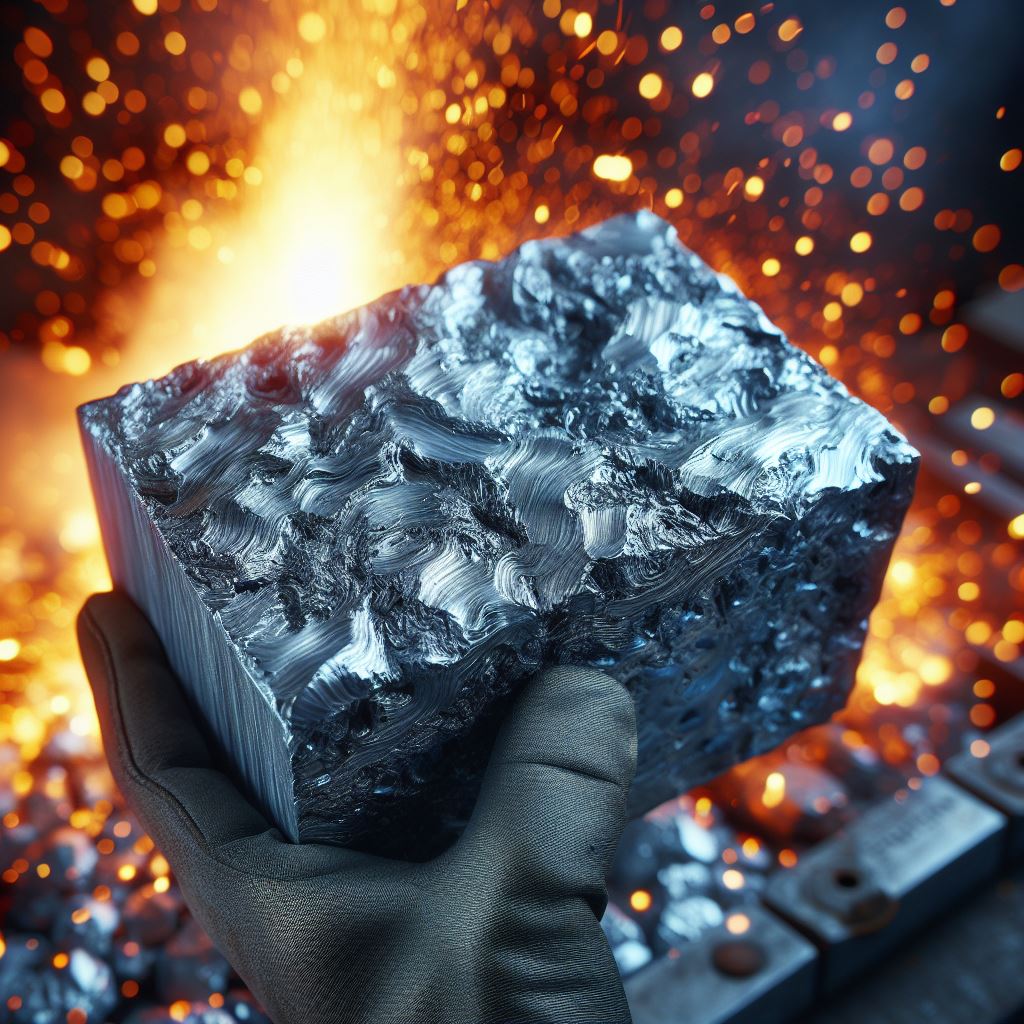Introduction to Titanium Metal and Its Unique Properties
Titanium, a transition metal known for its remarkable combination of strength, low density, and corrosion resistance, has revolutionized various industries, becoming a cornerstone of modern materials science. Discovered in 1791 by William Gregor, titanium was named after the Titans of Greek mythology, symbolizing its strength.
Properties of Titanium Metal
1. Strength:
Titanium boasts a strength-to-weight ratio superior to many metals, making it a go-to material for applications demanding high strength and structural integrity. Its strength is comparable to that of steel but with only 45% of its weight.
2. Lightweight Nature:
As a low-density metal, titanium is exceptionally lightweight. This characteristic is particularly advantageous in industries where weight reduction is critical, such as aerospace and automotive.
3. Corrosion Resistance:
One of titanium’s most remarkable attributes is its corrosion resistance, even in harsh environments. This makes it an ideal choice for applications requiring durability in challenging conditions.
Importance of Strength, Lightweight, and Corrosion Resistance in Various Industries

1. Aerospace Industry:
In aerospace, where the demand for high-performance materials is paramount, titanium has found extensive use. Its combination of strength and low weight contributes significantly to aircraft design, enhancing fuel efficiency and overall performance.
2. Automotive Industry:
The automotive sector benefits from titanium’s lightweight nature, enabling the manufacture of lighter vehicles without compromising structural integrity. This, in turn, improves fuel efficiency and reduces environmental impact.
3. Medical Industry:
Titanium’s biocompatibility and corrosion resistance have made it a staple in medical applications, particularly for implants. From prosthetics to dental implants, titanium’s properties contribute to the longevity and reliability of medical devices.
4. Sports Industry:
Sports equipment, such as bicycles, golf clubs, and tennis rackets, benefits from titanium’s lightweight and strong characteristics. Athletes gain a competitive edge with equipment that is both durable and lightweight.
Applications of Titanium Metal
1. Aerospace:
Titanium is a cornerstone of aerospace engineering. Its use in aircraft components, such as wings, landing gear, and structural elements, contributes to improved fuel efficiency and performance. Notable examples include the Boeing 787 Dreamliner, which extensively utilizes titanium in its construction.
2. Automotive:
In the automotive industry, titanium finds applications in exhaust systems, suspension components, and valves. The lightweight nature of titanium contributes to fuel efficiency and enhances overall vehicle performance.
3. Medical:
The medical field extensively relies on titanium for implants due to its biocompatibility and resistance to corrosion. Titanium implants, including hip and knee replacements, offer long-term stability within the human body.
4. Sports:
Sports equipment manufacturers incorporate titanium into products like bicycle frames, golf club heads, and tennis racket frames. This enhances performance for athletes by providing robust yet lightweight equipment.
Advantages of Using Titanium Metal
1. Comparisons with Steel:
Compared to steel, titanium offers similar strength but at a fraction of the weight. This is a game-changer in industries where weight is a critical factor, such as aerospace and sports.
2. Comparisons with Aluminum:
While aluminum is lightweight, titanium surpasses it in terms of strength. This makes titanium a preferred choice in applications where both strength and low weight are crucial, like aerospace components.
Manufacturing Processes of Titanium Metal

1. Extraction:
Titanium is primarily extracted from minerals such as ilmenite and rutile. The Kroll process, developed in the 1930s, remains the predominant method. It involves reducing titanium tetrachloride with magnesium, resulting in a titanium sponge.
2. Purification:
The extracted titanium sponge undergoes further purification to remove impurities. This often involves vacuum distillation or more advanced techniques like the iodide process.
3. Alloying Techniques:
Titanium alloys are created to enhance specific properties. Common alloying elements include aluminum, vanadium, and nickel. Alloying allows for tailoring titanium’s characteristics to meet the requirements of diverse applications.
Environmental Considerations and Sustainability of Titanium Metal Production
1. Extraction Impact:
While titanium extraction itself can be energy-intensive, advancements in sustainable energy sources are mitigating its environmental impact. Researchers are exploring greener extraction methods to minimize the ecological footprint.
2. Recyclability:
Titanium is fully recyclable, contributing to its sustainability. Recycling titanium requires less energy compared to primary extraction, making it an eco-friendly option for reducing waste and conserving resources.
Challenges and Limitations Associated with the Use of Titanium
1. Cost:
The cost of titanium remains a significant drawback, primarily due to the energy-intensive extraction process. This can limit its widespread adoption, especially in price-sensitive industries.
2. Machinability:
Titanium’s strength poses challenges in machining. Specialized equipment and techniques are often required, adding to production costs.
Ongoing Research and Future Prospects for Titanium Metal
1. Research Focus:
Ongoing research in titanium is diverse, spanning improved extraction methods, alloy development, and novel applications. Researchers aim to address existing limitations and discover new possibilities for this versatile metal.
2. Additive Manufacturing:
The rise of additive manufacturing, or 3D printing, has opened new avenues for titanium applications. This method allows for intricate designs and reduced waste, potentially overcoming some of the challenges associated with traditional manufacturing.
3. Biomedical Innovations:
In the medical field, ongoing research focuses on enhancing the biocompatibility of titanium implants and developing new medical devices. Advances in surface modifications aim to improve integration with the human body.
Additional Topics
Comparison with Other High-Strength Metals
Steel:
While titanium shares similar strength with steel, its lightweight nature provides a distinct advantage. In applications where weight is critical, like aerospace, titanium outshines steel.
Aluminum:
Titanium surpasses aluminum in terms of strength, making it preferable in applications requiring both strength and low weight. Aluminum, however, remains cost-effective and widely used in less demanding applications.
Role of Titanium Alloys
Titanium alloys play a crucial role in tailoring the metal’s properties. For instance, the addition of vanadium enhances strength, while aluminum improves corrosion resistance. These alloys allow for customization based on specific industry requirements.
Notable Examples of Titanium Metal Applications

Aircraft Construction:
The Airbus A380 and Boeing 787 Dreamliner showcase titanium’s role in aircraft construction. From structural components to engine parts, titanium enhances performance and fuel efficiency.
Medical Prosthetics:
Titanium’s biocompatibility is exemplified in medical prosthetics. Devices like hip and knee replacements made from titanium provide patients with durable and biologically compatible solutions.
Sports Equipment:
In sports, titanium’s use in bicycle frames, golf clubs, and tennis racket frames exemplifies its impact on equipment performance. Athletes benefit from the combination of strength and low weight.
Impact on Fuel Efficiency in Aerospace – Titanium Metal
Titanium’s lightweight nature directly contributes to improved fuel efficiency in the aerospace industry. Reduced aircraft weight translates to lower fuel consumption, making titanium a key player in the pursuit of more sustainable aviation.
Titanium Metal in Medical Implants and Biocompatibility – Titanium Metal
The biocompatibility of titanium is a crucial factor in its use for medical implants. Titanium’s inert nature minimizes the risk of adverse reactions in the human body, contributing to the long-term success of implants.
Cost Factors and Economic Considerations – Titanium Metal
Despite its exceptional properties, the cost of titanium remains a challenge. Factors such as energy-intensive extraction, specialized machining requirements, and limited production scale contribute to its relatively high cost compared to other metals.
Environmental Benefits and Recyclability
Titanium’s recyclability aligns with growing environmental concerns. The energy savings associated with recycling make it an environmentally friendly option. However, ongoing efforts are needed to improve extraction processes and reduce environmental impact.
Emerging Trends and Advancements of Titanium Metal
Additive Manufacturing:
The use of additive manufacturing in titanium production is a notable trend. 3D printing allows for intricate designs, reduced material waste, and improved cost-effectiveness.
Surface Modifications:
Advancements in surface modifications aim to enhance the performance of titanium implants. Innovative coatings and treatments improve integration with surrounding tissues, extending the lifespan of medical devices.
In conclusion, titanium’s exceptional properties have positioned it as a game-changer in various industries. Its strength, lightweight nature, and corrosion resistance contribute to technological advancements from aerospace to medicine. Ongoing research and innovations, including additive manufacturing and biomedical advancements, promise a future where titanium continues to push the boundaries of what is possible in materials science.
Key Takeaways:
- Titanium’s strength, lightweight nature, and corrosion resistance make it a versatile material.
- Its applications span aerospace, automotive, medical, and sports industries, contributing to improved performance and efficiency.
- Titanium’s advantages over other metals include a superior strength-to-weight ratio.
- Manufacturing involves extraction, purification, and alloying processes, with ongoing efforts for greener practices.
- Sustainability is addressed through titanium’s recyclability, though cost and energy consumption remain challenges.
- Ongoing research explores additive manufacturing, biomedical innovations, and surface modifications.
- Titanium’s impact on fuel efficiency in aerospace and its biocompatibility in medical implants are notable.
- Economic considerations include the relatively high cost of titanium compared to other metals.
- Environmental benefits include recyclability and potential improvements in extraction processes.
- Emerging trends focus on additive manufacturing, surface modifications, and expanding applications beyond traditional industries.
Limited Offer: Wonderful Guide on Titanium Dioxide in Vitamins






Pingback: New Insights Into The Fascinating Structure Of Titanium Dioxide - Safe Climber Overseas Pvt. Ltd.
Pingback: Titanium Dioxide Toxicity: What You Need to Know - Safe Climber Overseas Pvt. Ltd.